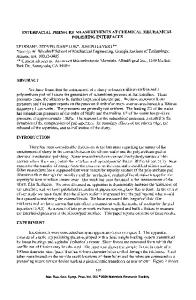Chemical Reactions at Glass/Liquid Interfaces
- PDF / 434,672 Bytes
- 6 Pages / 414.72 x 648 pts Page_size
- 91 Downloads / 389 Views
CHEMICAL REACTIONS AT GLASS/LIQUID INTERFACES KIM F. FERRIS, C.P. SOSA AND L.R. PEDERSON Pacific Northwest Laboratory[l], Materials and Chemical Sciences Center, Richland, WA 99352 ABSTRACT Electronic structure calculations were performed on model silicate complexes in the presence of a perturbing dielectric field. Solid state dielectric effects were represented by an electrostatic representation of surrounding molecular subunits, which were developed from quantum mechanical electron density distributions. Only minor changes in the molecular geometry of the surface silicate model were noted; however, significant intramolecular charge redistribution and intermolecular interaction energy changes occur in the presence of the perturbing field. Molecular probes of surface absorption show a differential stabilization of donor and acceptor interactions for hydrogen bonding species. INTRODUCTION Although the aqueous durability of ceramic materials has been the subject of numerous studies, the basis processes at the reaction interface are still poorly understood. Much of our current interpretation of the basic surface reactions comes from two sources; equilibrium thermodynamic information which forms our basis for long durability predictions, and chemical mechanism from isolated molecule information. The aqueous corrosion reactions of alkali silicate based materials are often discussed in terms of ion exchange and hydrolysis reactions involving the glass matrix[2]. A crucial step in both these processes involves the interaction of molecular forms of water with a silicate surface species[3]. These sources of information offer comparatively simple models in face of the multiple reactions occurring at solid-liquid interfaces. In the surface reaction schematic shown in Figure 1 below, a number of interactions such as solid-solid, solid-solution, and absorbant-solid can be quickly envisioned as forming the basis for a model of surface reactivity. However, model complexes for most part are truncated molecular representations, often being silicic acid or silanol as models for the silicate surface. Such models are simply short range representations of the molecular interactions of the solid. One obvious effect of this approach is to demonstrate the effects of truncation in the model complex. Recent results indicate that the use of
0
0 , 0
0,
\_,I
_ H
oo
IH
I
HH/ H
H'
HH
(A)
(B)
Figure 1 - Molecular representation of the ceramic surface in an aqueous environment (A) and truncated complexes (B) using model reactions.
Mat. Res. Soc. Symp. Proc. Vol. 172. ©1990 Materials Research Society
66
silanol for the surface model biases the surface absorption results on two accounts: 1) lack of multiple interactions for a water molecule with the silica surface by using H instead of -0-Si[4], and 2) accentuating the stability of acceptor interactions for water as compared to silicic acid[5]. Further perturbations to these interactions are expected if the solid were represented accurately as opposed to using oxygens terminated by
Data Loading...










